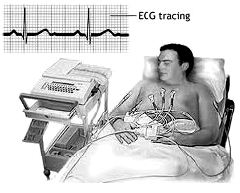ECG is the abbreviated form of the word electrocardiogram. ECG is a diagnostic procedure that is routinely used to assess the electrical and muscular functions of the heart. We know that the heart produces tiny electrical impulses without any external stimulation. This electrical signal spread through the heart muscle to make the heart contract. We detect these impulses by the ECG machine. With the help of ECG we can measure the rate and rhythms of heartbeats. It gives indirect evidence of blood flow in the heart.
The electrodes placed on the different parts of the body detect the electrical impulses coming from different directions within the heart. To get a complete picture of the heart, twelve signals are identified using ten electrodes. An electrode lead is placed on each arm and leg i.e. total of four and rest six electrodes are placed across the chest wall [Figure]. The signals received from each electrode are recorded. The printed view of these recordings is the electro gram.

For a healthy person, there are normal patterns of the electrical impulses from each electrode. If any type of abnormal condition is observed in the heart of a person, then the patterns from the electrodes will be different from that of a normal pattern.
Generally, ECG test is done to find the cause of external symptoms such as- palpitations, irregular and fast heart beat, chest pain etc. of some diseases. Sometimes it is done as a part of routine tests- for example, before you have an operation you can take the help of ECG. The heart disorders that can be detected by ECG are:
- Abnormal heart rhythms- for example, if the heart is very fast, very slow or irregular.
- A heart attack- which happened recent or some time ago.
- An enlarged heart- i.e. the size of the heart is increased.













